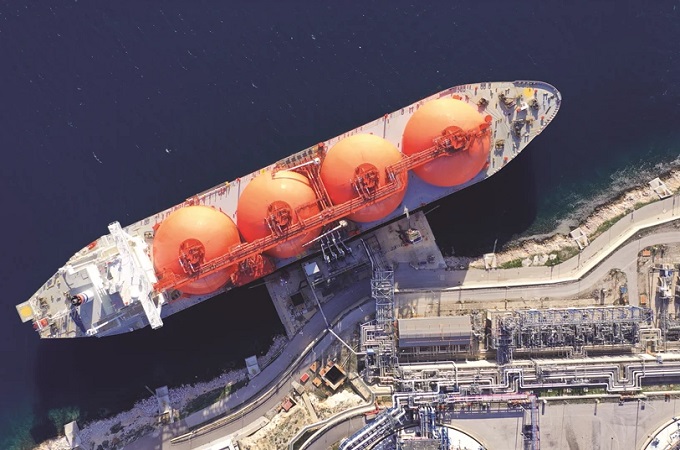
Despite a temporary truce, the sweeping tariffs introduced by the US President Donald Trump against multiple trading partners are set to have far-reaching consequences, including significant implications for global LNG markets, said an expert in its report in Energy Connects.
The 10 percent US tariff imposed on China in February 2025 quickly resulted in a tit-for-tat escalation by April. Despite a 90-day tariff reprieve announced mid-May, US LNG is still subject to a 25% tariff, making it uneconomic to send it to China.
As a result, China ceased importing US LNG cargoes as of February 6, 2025; these cargoes are now being diverted to Europe. These imports are unlikely to resume while Chinese tariffs remain in place; in the long term, mistrust is likely to remain between the largest LNG export and importer, stated Anne-Sophie Corbeau, the Global Research Scholar at Center on Global Energy Policy at Columbia University.
Tight global gas market conditions
In contrast, lower tariffs imposed on other major importers of US LNG – such as EU countries, Japan, and South Korea – are unlikely to trigger similar retaliation. This is largely due to current tight global gas market conditions and the limited availability of alternative gas suppliers.
EU countries, which imported around 50 billion cubic meters (bcm) of US LNG in 2024, are expected to increase their purchases in 2025 to replenish storage facilities and replace Russian gas previously transiting through Ukraine.
Imposing retaliatory tariffs on US LNG would only drive up energy costs for European consumers and hurt the EU economy without real added benefit.
US LNG as a negotiating tool
President Trump has repeatedly emphasised that countries affected by tariffs should help balance their trade deficits by increased purchases of US LNG. In practice, this goal is largely unrealistic.
For instance, the EU would need to import nearly 20 times more LNG (based on 2024 figures) to offset its $236 billion trade deficit with the US. The same holds true for mature LNG importers like Japan, South Korea, and Taiwan, as well as emerging LNG importers like Vietnam, said Anne in the Energy Connects report.
Commercial viability of projects
But even if numbers don’t add up, there has been mounting pressure on governments and companies to contract more US LNG, especially from plants that have yet to reach a final investment decision (FID).
Japanese, Korean, and Taiwanese stakeholders have been encouraged to look into buying LNG from the Alaska LNG project, while Vietnam has signed agreements to cooperate with US companies to explore US LNG imports, she stated.
Whether these discussions lead to firm Sale and Purchase Agreements (SPAs) remains uncertain, as such decisions are ultimately driven by projects’ commercial viability, she added.
Preserving the flexibility of US LNG
There is a certain irony in using US LNG to address trade imbalances. Even if European, Japanese, or Korean buyers sign long-term contracts for US LNG, it is uncertain whether those shipments will physically arrive in their countries.
Since exports from the US Lower 48 began in 2016, the defining feature of US LNG has been its flexibility – allowing offtakers to redirect cargoes to any LNG importing country based on price signals and market demand.
If – in the name of plugging trade deficits – US LNG were to have more fixed destinations, this would undermine one of the key competitive advantages that US LNG has against other competitors such as Qatar. Preserving this flexibility should remain a priority in future negotiations, stated the Energy Connects report.
Disappearing cost advantages
US tariffs on steel and aluminum imports are likely to directly impact US LNG export facilities, especially those currently under construction or aiming to reach FID.
These metals are critical components in LNG infrastructure, including cryogenic tanks and heat exchangers, while the tariffs affect upstream and midstream operations by increasing the cost of well construction, pipeline development, and surface infrastructure.
These rising costs are expected to influence upcoming LNG contract negotiations and may even spill over into existing agreements, as producers seek to renegotiate for higher prices. This could potentially give some buyers – particularly in China – a legal or commercial avenue to exit their contracts, said Anne in the report.
According to her, the timing is particularly challenging. The Energy Information Administration (EIA) now projects that US gas prices will exceed $4/mmBtu in both 2025 and 2026 (against $2.2 in 2024).
Meanwhile, declining oil prices are making oil-indexed gas contracts more attractive, potentially tilting the competitive balance away from US LNG. While current prices may not accurately reflect long-term pricing trends, they nonetheless influence ongoing contract negotiations for the global LNG industry, she added.
